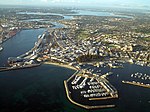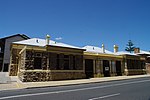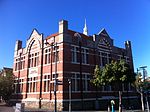Kings Square, Fremantle
Adelaide Street, FremantleHigh Street, FremantleQueen Street, FremantleSquares in Perth, Western AustraliaUse Australian English from May 2013

Walyalup Koort, formerly known as Kings Square (or King's Square), is a town square in Fremantle, Western Australia. It is bounded by Queen, Newman, William, and Adelaide Streets. Though the square was originally a public reserve, it has been the site of Saint John's Church of England since 1843, and the Fremantle Town Hall since 1887. High Street was extended through and beyond the square in the 1880s, but the portion through the square was closed off in the 1960s. Today Kings Square functions as a civic and cultural centre of Fremantle, with modern events taking place adjacent to the historic buildings.
Excerpt from the Wikipedia article Kings Square, Fremantle (License: CC BY-SA 3.0, Authors, Images).Kings Square, Fremantle
High Street,
Geographical coordinates (GPS) Address Nearby Places Show on map
Geographical coordinates (GPS)
| Latitude | Longitude |
|---|---|
| N -32.0539 ° | E 115.7483 ° |
Address
High Street
High Street
6959
Western Australia, Australia
Open on Google Maps











